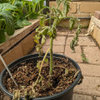Controlling bacterial speck: mancozeb?
david49
18 years ago
Related Stories

KITCHEN DESIGNKitchen Countertops 101: Choosing a Surface Material
Explore the pros and cons of 11 kitchen countertop materials. The options may surprise you
Full Story
KITCHEN DESIGNKitchen of the Week: Drab and Dysfunctional to Radiant in Minnesota
Clunky storage and lackluster floors get nixed in favor of open shelves, plaid vinyl and an effective kitchen work triangle
Full StoryMore Discussions







carolyn137
Related Professionals
Surprise Landscape Contractors · Williamsburg Landscape Contractors · Edmond Landscape Contractors · Ashburn Landscape Contractors · Bergenfield Landscape Contractors · Cudahy Landscape Contractors · East Chicago Landscape Contractors · El Reno Landscape Contractors · Kaysville Landscape Contractors · Lady Lake Landscape Contractors · Plymouth Landscape Contractors · Santa Ana Landscape Contractors · 07920 Landscape Contractors · East Norriton Landscape Contractors · Carmel Siding & Exteriors